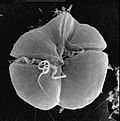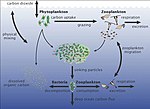Karenia brevis is a microscopic, single-celled, photosynthetic organism in the genus Karenia. It is a marine dinoflagellate commonly found in the waters...
30 KB (3,661 words) - 07:46, 21 May 2024
researching Karenia brevis. 12 species have been described in the genus Karenia thus far: Karenia asterichroma Karenia bicuneiformis Karenia brevis Karenia brevisulcata...
12 KB (1,488 words) - 01:18, 13 March 2024
used in the US to refer to Karenia brevis blooms in the eastern Gulf of Mexico, also called the Florida red tide. K. brevis is one of many different species...
163 KB (18,175 words) - 14:24, 21 August 2024
compounds produced naturally by a species of dinoflagellate known as Karenia brevis. Brevetoxins are neurotoxins that bind to voltage-gated sodium channels...
25 KB (3,235 words) - 18:26, 26 July 2024
specific kinds of phytoplankton causing the bloom. Some examples are Karenia brevis in the Gulf of Mexico, Alexandrium fundyense in the Gulf of Maine, Margalefadinium...
41 KB (4,274 words) - 02:16, 4 June 2024
these toxic fish from the brevetoxin produced by the dinoflagellate Karenia brevis. Brevetoxins are neurotoxins that can cause acute respiratory and neurological...
48 KB (4,852 words) - 04:57, 9 September 2024
brevetoxins, which are marine toxins produced by the dinoflagellate Karenia brevis (among several others). These toxins can produce a series of gastrointestinal...
10 KB (1,074 words) - 17:34, 25 November 2023
for the proliferation, or "blooms", of the microscopic marine algae Karenia brevis. This dinoflagellate produces brevetoxins that can have toxic effects...
67 KB (6,739 words) - 11:11, 10 August 2024
which sometimes occurs on beaches is caused by a type of algae known as Karenia brevis. Crimson rosellas are a subspecies of parrot that are common in Australia...
13 KB (1,472 words) - 17:16, 7 August 2024
identified toxins that are shown to kill marine life. For example, Karenia brevis has brevetoxins. It is believed that its killing effects are due to...
6 KB (708 words) - 01:08, 13 March 2024
birds and mammals, are affected by periodic outbreaks of red tide (Karenia brevis). The Sound is relatively shallow in many locations, and boaters are...
3 KB (368 words) - 15:05, 27 September 2023
increases. Red tide is the name commonly given to an algal bloom of Karenia brevis, a microscopic marine dinoflagellate which is common in Gulf of Mexico...
51 KB (4,992 words) - 18:30, 29 August 2024
top spot three times since 2015. In 2018 the beaches were impacted by Karenia brevis, an algae drift known as red tide. Several tons of dead fish washed...
7 KB (813 words) - 00:09, 19 May 2024
rDNA indicates Karenia selliformis, together with K. papilionacea and K. bicuneiformis, is closely related to K. mikimotoi and K. brevis. Haywood, Allison...
6 KB (574 words) - 01:12, 13 March 2024
intentional killing of the manatees. Red tide, a harmful algae bloom of Karenia brevis that releases toxins into the water, kills many marine species. In 1982...
81 KB (8,793 words) - 19:40, 31 August 2024
a genus of parasitic dinoflagellates, causes velvet disease in fish Karenia brevis produces red tides highly toxic to humans Red tide A mixotroph is an...
77 KB (7,077 words) - 22:15, 6 September 2024
their typical golden brown color. However, the dinoflagellates Karenia brevis, Karenia mikimotoi, and Karlodinium micrum have acquired other pigments...
96 KB (10,335 words) - 11:32, 9 September 2024
where she earned a Ph.D. She wrote her dissertation on the genomics of Karenia brevis, a species of plankton that causes toxic red tide in the Gulf of Mexico...
41 KB (3,045 words) - 00:23, 7 September 2024
rDNA indicates Karenia papilionacea, together with K. selliformis and K. bicuneiformis, is closely related to K. mikimotoi and K. brevis. Haywood, Allison...
3 KB (364 words) - 01:22, 13 March 2024
Prince et al. showed that chemical exudates from the dinoflagellate Karenia brevis decreased the growth rate and sometimes killed competitor species by...
27 KB (2,521 words) - 15:56, 11 July 2024
defined using multiple measurements at only one location. A study on the Karenia brevis algae responsible for more recent and increasingly longer red tide blooms...
13 KB (1,592 words) - 19:19, 15 January 2024
rDNA indicates Karenia bicuneiformis, together with K. selliformis and K. papilionacea, is closely related to K. mikimotoi and K. brevis. Haywood, Allison...
4 KB (401 words) - 01:20, 13 March 2024
edu/publication/SG188 Landsberg, J. H.; Flewelling, L. J.; Naar, J. (2009-03-01). "Karenia brevis red tides, brevetoxins in the food web, and impacts on natural resources:...
71 KB (8,277 words) - 16:26, 13 August 2024
Asterodinium Sournia Brachidinium Sournia Gertia K.Takahashi et Iwataki Karenia G.Hansen et Moestrup Karlodinium Larsen Shimiella Ok, Jeong, Lee et Noh...
4 KB (329 words) - 08:23, 8 July 2024
decrease in nutrient flow to lower levels of the ocean. Dinoflagellates Karenia brevis produces red tides highly toxic to humans. Red tide Diplonemids may...
82 KB (8,313 words) - 02:10, 27 August 2024
Gymnodiniaceae Landsberg, J.H.; Flewelling, L.J.; Naar, J. (March 2009). "Karenia brevis red tides, brevetoxins in the food web, and impacts on natural resources:...
4 KB (359 words) - 01:11, 13 March 2024
a genus of parasitic dinoflagellates, causes velvet disease in fish Karenia brevis produces red tides highly toxic to humans Red tide Noctiluca scintillans...
232 KB (21,388 words) - 09:31, 2 June 2024
lineages. The fucoxanthin dinophyte lineages (including Karlodinium and Karenia) lost their original red algal derived chloroplast, and replaced it with...
194 KB (18,827 words) - 15:18, 29 August 2024
ground for algal blooms, including the notorious Red Tide algae species Karenia brevis. These increases in groundwater nitrate concentrations are not only...
16 KB (1,946 words) - 05:54, 22 November 2023
research projects into the chemical signals from the red tide producing Karenia brevis. Through screening of compounds produced by sea squirts, Kubanek's lab...
13 KB (1,309 words) - 15:25, 16 May 2024



















